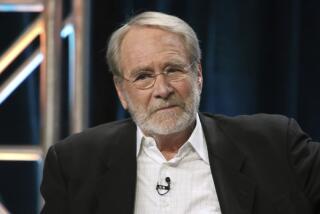‘MURROW’--HBO’S VERSION OF A JOURNALIST’S LIFE
- Share via
HBO’s disputed, highly watchable biography of Edward R. Murrow blackens the CBS Eye. Naturally it’s provocative, for Murrow was provocative, making provocative waves in a provocative era, and smoking himself to death as America watched.
Premiering at 8 p.m. Sunday, “Murrow” stars Daniel J. Travanti as the man most responsible for establishing high standards of integrity and professionalism at CBS News. In the 1950s, Murrow’s pioneering “See It Now” series was the news division’s hottest ticket and boldest signature, reaching a zenith with 1954 attacks on the demagoguery and gutter tactics of Sen. Joseph R. McCarthy.
The irony is that high-horsing “Murrow” arrives on cable-delivered Home Box Office at a time when CBS News morale is said to be especially low and the division so tenuous as to have prompted a recent change of command back to Van Gordon Sauter.
From Edward R. Murrow to Phyllis George, the CBS News record has been long and varied. “Murrow” is a fascinating, well-told, well-acted chronicle of one man’s contributions to an infant news medium that swiftly soared far beyond radio to new levels of influence and power. Beware, however, for this Jack Gold-directed drama from Titus Productions is yet another dramatic re-creation of history, subject to the usual questions about accuracy and interpretation.
The story traces Murrow’s CBS career from his famed World War II radio reports from London through his emergence as the network’s journalistic conscience in an era of Communist-fearing hysteria that shook broadcasting to its argyles. The ending comes with Murrow’s death in 1965. That was four years after he had left CBS and 10 years after “See It Now” lost its regular time slot to a sitcom the way historic buildings are leveled for parking lots.
Much of Ernest Kinoy’s script pits Murrow’s journalistic idealism and heroism against the bottom lining-profit ethic of CBS President Frank Stanton (John McMartin) and ultimately CBS Chairman William S. Paley (Dabney Coleman).
Stanton is shown mostly being less sensitive to news integrity than to Nielsen ratings and pressure from stockholders, sponsors and Congress. Paley is depicted as being of two minds, if not two faces. “I’ll be with you tonight,” he assures Murrow in the tense and prickly moments before the first “See It Now” assault on McCarthy. And he adds: “I’ll be with you tomorrow.”
Yet Paley ultimately bows to commercial pressures, first by trimming “See It Now” to periodic airings and finally by canceling it altogether. Near the end of the story, Paley appears to be seeking some kind of absolution from a dying Murrow.
There is an earlier, neatly executed scene, though, that typifies their differences. At a meeting of CBS board members verging on capitulation to McCarthyism, Murrow speaks up for news independence and is supported by Paley. Then, almost casually, Paley adds that he will require loyalty oaths from all CBS employees. It’s the movie’s only clear indication of just how far CBS went in sacrificing its employees to appease the witch hunters.
Although lacking the commanding broadcast voice of Murrow, Travanti effectively conveys the quiet grit and taciturn presence of someone who became a metaphor for TV journalism’s best and bravest.
Coleman plays Paley to the convincing hilt as a man who insulates Murrow for years before ultimately pulling the rug. McMartin is credible as as a fiscal-minded Stanton and Edward Herrmann is believable as Murrow’s friend and co-producer, Fred Friendly. There’s also a dandy cameo by David Suchet as William L. Shirer.
Elements of “Murrow” have been savaged by a number of past and present CBS people, including Walter Cronkite and “60 Minutes” Executive Producer Don Hewitt, who was the director for “See It Now.” The casting itself may have stacked the deck against CBS, as Travanti is best known as the honorable Capt. Furillo on NBC’s “Hill Street Blues” and Coleman for playing a string of deceitful characters.
That and the fallibility of docudrama as fact are reasons to condemn a recent showing of “Murrow” at the National Press Club in Washington to help raise funds for the prestigious Reporters Committee for Freedom of the Press.
It’s bad enough that undocumented docudramas are cluttering prime time and altering more facts than they authenticate. Presenting “Murrow” in a news environment, though, is an added dangerous step that implies validation when none may be deserved.
Aside from that, “Murrow” is certainly something to chew on. Murrow was no uncompromising super moralist: Witness his participation in those shallow “Person to Person” celebrity interviews. Nor was Murrow even the first journalist to attack McCarthy, as he points out in the movie.
Yet think a bit about Murrow and what he exemplifies.
The last scene of this movie shows an empty outdoors bench where an ailing Murrow spent his final days watching the sea. Empty .
Though a tad melodramatic, it’s a reminder that no single person in TV news today has the aura and prestige that Murrow had. Oh, there are a few, but they are anchormen, admired less for their words or ideas or ideals than for their personalities.
Symbols can matter as much as reality. That’s why it’s important to sustain Murrow as a model, even if the legend may conflict with the man.
More to Read
The complete guide to home viewing
Get Screen Gab for everything about the TV shows and streaming movies everyone’s talking about.
You may occasionally receive promotional content from the Los Angeles Times.






